Examine suspended program
Debug tool window: View | Tool Windows | Debug or
After the debugger session has started, the Debug tool window will appear, and the program will run normally until one of the following happens:
a breakpoint is hit
you manually pause the program
After that, the program is suspended, allowing you to examine its current state, control its further execution, and test various scenarios at runtime.
The state of the program is represented by frames. When the program is suspended, the current frame stack is displayed on the Frames tab of the Debug tool window.
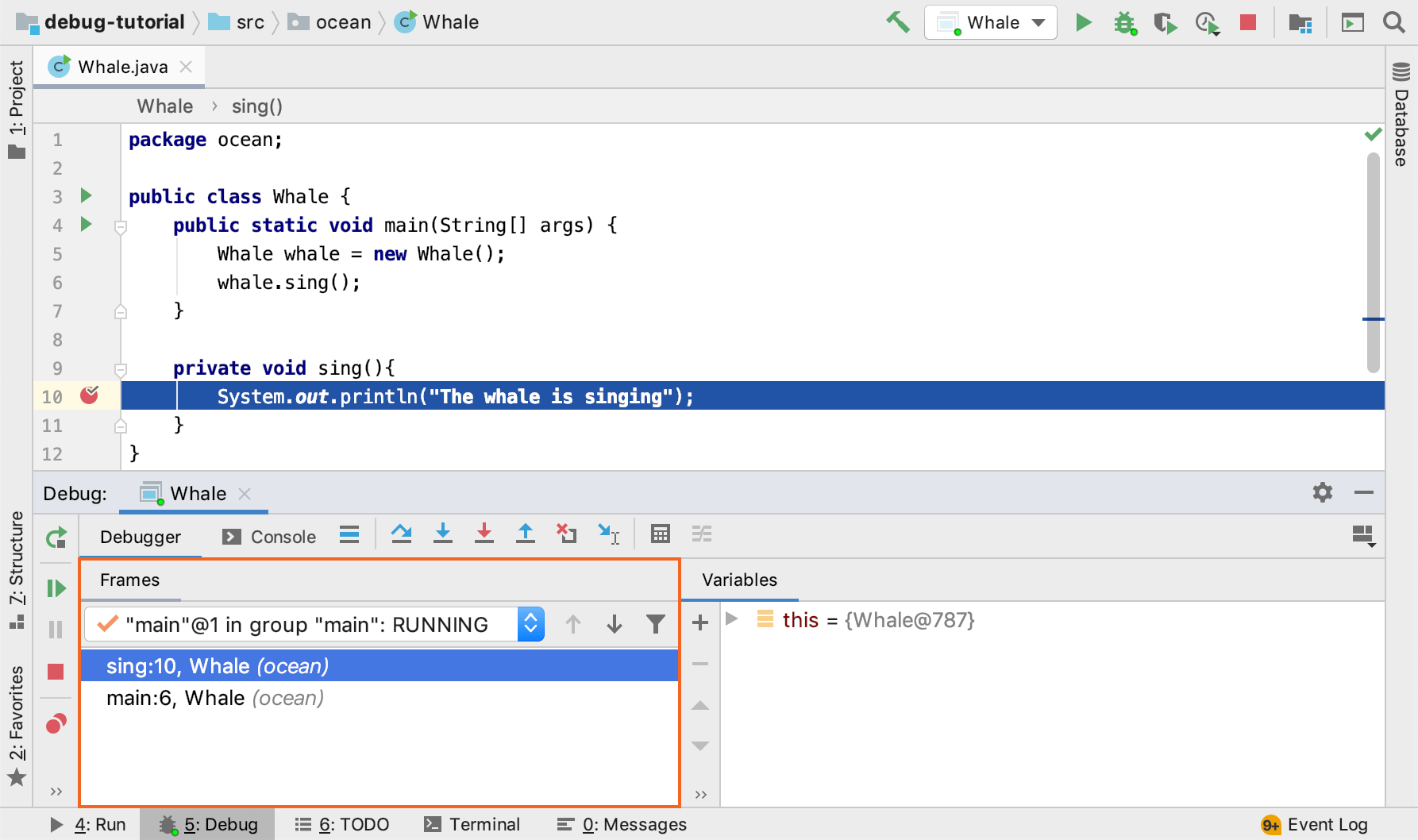
A frame corresponds to the active method or function call. It stores the local variables of the called method or function, its arguments, and the code context that enables expression evaluation.

To better understand the concept of frames, let's look into what happens when a program is run. The execution of the program starts from the main method, which in turn calls other methods. Each of these methods may do more method calls. The set of local variables and parameters for each method call is represented by a frame. Each time a method is called, a new frame is added to the top of the stack. When the execution of a method is complete, the corresponding frame is removed from the stack (in the last in, first out fashion).
tip
When you select a frame, the corresponding file will open in a preview tab, which means that it will close when you navigate away from this frame. To open the file in a regular tab, double-click the frame. To change this behavior, click Show Options Menu
on the toolbar of the Debug tool window, then select Open Files in Preview Tab.
Examining frames helps you understand why particular parameters were passed to a method and what the state of the caller was at the time of calling.
Thread statuses are provided by Java to reflect what is currently happening to the thread in the program.
Thread status | Description |
|---|---|
MONITOR | The thread is waiting on a Java monitor. |
NOT_STARTED | The thread has not yet been started. |
RUNNING | The thread is active and running. |
SLEEPING | The thread is sleeping because |
UNKNOWN | The thread status is unknown. |
WAIT | The thread is waiting after |
ZOMBIE | The thread has completed execution. |
Icons near each thread indicate the status of the thread relative to the current debugging session.
Icon | Description |
|---|---|
The current thread in suspended state. | |
An active thread. | |
The thread that has hit the current breakpoint. | |
A suspended thread. Threads are marked as suspended when they were paused by the debugger. | |
A frozen thread. Threads are marked as frozen when they were manually paused. |
If your program uses external libraries, and you want to omit calls made in library classes, click the Hide Frames from Libraries button
located in the top-right part of the Frames pane.
To copy the call stack for the current thread, right-click anywhere on the Frames tab and select Copy Stack.
If you need to get a report containing the state of each thread and its stack trace, use the Export Threads option. This is useful when you need to share the information about the threads in text format.
Right-click anywhere on the Frames pane and select Export Threads from the menu.

To save a report as a text file, specify the path to the file in the Export Threads dialog and click Save, or click Copy to copy it to the clipboard.

The Variables tab shows the list of the variables in the selected frame/thread. Examining the variables can help you understand why the program operates in a certain way.
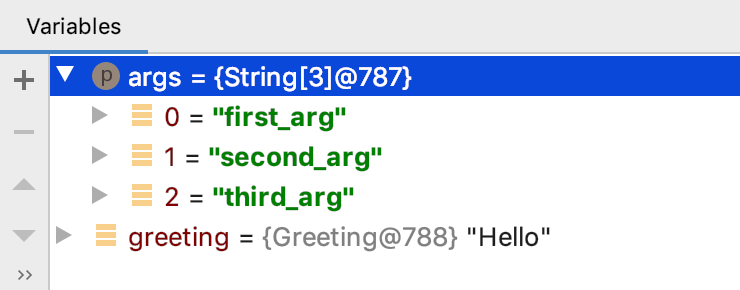
tip
Be mindful of variable scope and lifetime. If a variable is not present on the list, this means the variable is out of scope for the current frame at the current execution point.
The icon on the left of each variable indicates its type.
Icon | Description |
|---|---|
Static members of the enclosing class | |
Fields of an object (both static and nonstatic) | |
Fields containing a self-referencing object (for example, | |
Final fields | |
Static fields | |
A thrown exception (only displayed when an exception breakpoint was hit) | |
A method return value (only displayed when the Show Method Return Values option is enabled) | |
Method parameters | |
Enum constants | |
Local arrays | |
Local primitive types | |
Watches and auto-variables. | |
Local reference variables |
If an object has numerous fields, you can pin some of them, so that they are always displayed at the top of the list. The same priority will apply to other instances of this class.
In the Variables pane, click the icon that indicates the variable type.

When a field is pinned, a blue flag replaces the original icon. To unpin the field, click this flag.
When examining variables, you may need to copy a variable name or value to paste it somewhere else or to compare it with another variable.
To copy the value that a variable holds, right-click the variable and select Copy Value . For types other than
String, thetoStringrepresentation is copied.To copy the name of a variable, right-click the variable and select Copy Name.
When you need to compare a variable value with some other value, use the Compare Value with Clipboard option. This is helpful, for example, when a variable holds a long string, and you need to compare it with another long string.
Copy the content you want to compare (for example, from a text file).

In the Variables tab, right-click the variable that you want to compare with and select Compare Value with Clipboard.
Examine the differences in the Diff Viewer that opens. For more information about efficient using of the Diff Viewer, refer to the Comparing Files and Folders topic.

IntelliJ IDEA allows you to inspect variables in a dedicated dialog. This is useful when you need to keep track of some variable (or the object whose reference it holds) and at the same time be able to navigate between frames and threads.
Right-click a variable or a watch and select Inspect.

In the Variables tab of the Debug tool window, select an array or a DataFrame.
Click a link View as Array/View as DataFrame to the right.
Alternatively, you can choose View as Array or View as DataFrame from the context menu.
The Data View tool window appears.

If you want to test how the program would behave in certain conditions or fix its current behavior at runtime, you can do that by setting/changing the variable values.
Select a variable and press . Alternatively, select Set Value from the context menu.
Enter the value for the variable and press .

note
Due to a GDB/LLDB limitation, you cannot set value for
std::stringvariables.
If you need to look into the source code where some variable or class is declared, you can move there right from the Variables pane.
To navigate to the code where the variable is declared, right-click the variable and select Jump to Source .

To navigate to the class declaration of the variable type, right-click the variable and select Jump to Type Source .

To navigate to a method body from a stack trace element, click Navigate near the stack trace element on the Variables pane.

IntelliJ IDEA provides you with the information on the currently existing objects, which hold a reference to the objects on the Variables tab. The feature also detects indirect references, like those in anonymous classes using outside variables.
To view the list of referring objects, right-click a variable on the Variables tab and select Show Referring Objects.
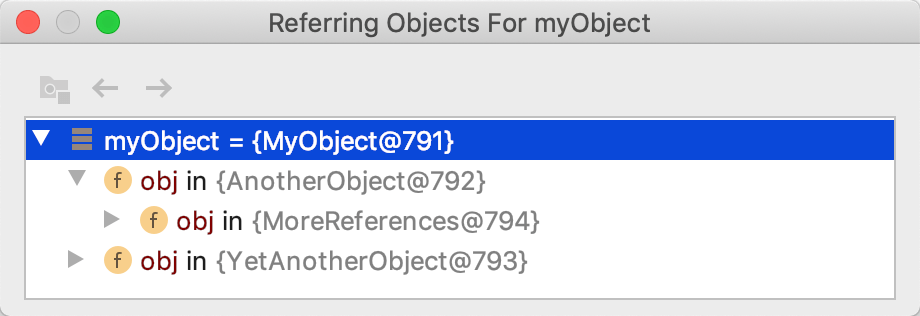
The Referring Objects dialog opens, allowing you to inspect the references to the selected object and to the referring objects themselves.
When you need the summary on all existing objects of some type, you can get it using the Memory tab of the Debug tool window.
Also, you can configure how different types are displayed. For example, you can use the 'toString' representation or create a custom renderer.
IntelliJ IDEA lets you evaluate expressions during a debugging session to obtain additional details about the program state or test various scenarios at runtime.
note
When evaluating expressions, be mindful of variable scope and lifetime. All expressions are evaluated in the context of the current execution point.
To quickly evaluate an expression, point at it in the editor. Note that method calls cannot be evaluated this way.
Point at the expression you want to evaluate. The result of the expression appears in a tooltip.

To view child elements of the resulting object, click
or press .

If you find value tooltips distracting, you can increase the delay or disable them altogether. To do this, in the Settings dialog (), go to Build, Execution, Deployment | Debugger | Data Views and set the Show value tooltip and Value tooltip delay options as required.
If you want to evaluate an expression in the code that involves a method call, or you want to be specific about which portion of expression to evaluate, use the Quick Evaluate Expression option.
note
This option is available only if the program was suspended after hitting a breakpoint (not paused manually).
Place the caret at the expression (to evaluate the closest matching expression) or select a portion of it (if you want to be specific about which part of a complex expression to evaluate).

Click Run | Debugging Actions | Quick Evaluate Expression . Alternatively, hold and click the selection.

note
If there are breakpoints inside the method called from the expression, they will be ignored.
tip
When calling methods, make sure you are aware of their possible side effects (for example, changes to an outside variable), as they may alter the program flow or result.
int hasSideEffects() { // returns the number of entries in the list someVariable++; return list.size(); }In the example, the value of
someVariablewill increment with each step, which may affect the behavior of the program.
You can configure Quick Evaluate to work for a piece of code on just selecting it (without using the menu/shortcut). Use this option carefully, as you can accidentally call methods when it is enabled.
To configure Quick Evaluate on code selection, go to Settings | Build, Execution, Deployment | Debugger | Data Views and set the Show value tooltip on code selection option as preferred.
Evaluating arbitrary expressions is the most flexible evaluating option. It lets you evaluate any code as long as it is in the context of the current frame. Using it, you can evaluate declarations, method calls, switch expressions, anonymous classes, lambdas, loops, and so on.
Use this feature to get additional information about the current state of the program and test various scenarios all within the same debugging session. This saves a lot of time by reducing the number of sessions you have to run.
note
This option is available only if the program was suspended after hitting a breakpoint (not paused manually).
The quickest way to evaluate an arbitrary expression is to enter it in the expression field in the Variables pane and press
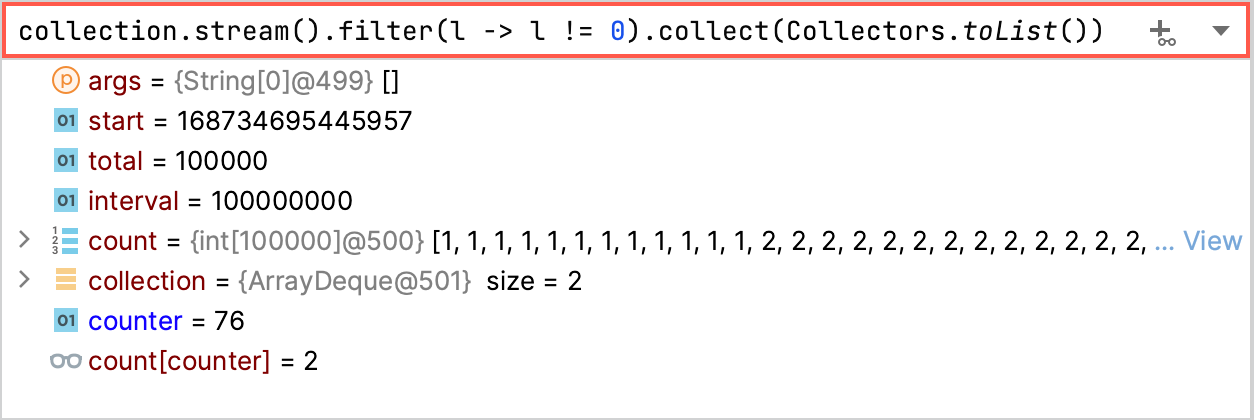
The result is displayed right below. You can also add the expression to watches by clicking in the right-hand part of the expression field.
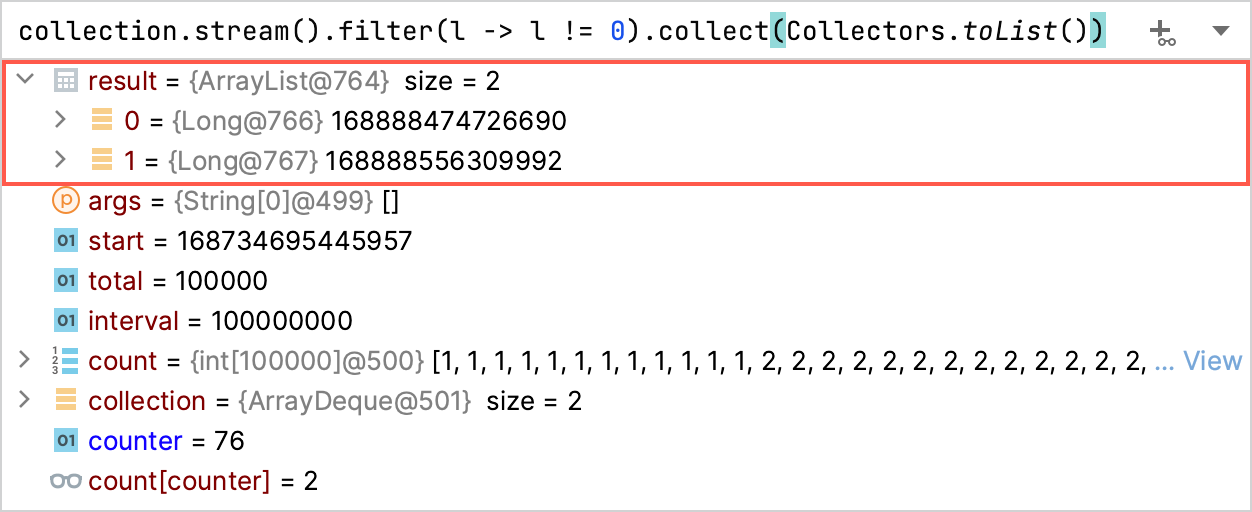
If you want to evaluate long code blocks, you may want to use a dedicated dialog for that:
If you want to start with some expression or a variable, which is currently in front of you (for example, in the editor or on the Variables pane), select it.

Click Run | Debugging Actions | Evaluate Expression . The shortcut may not work on Ubuntu (for correct operation, adjust the shortcut configuration).
In the Evaluate dialog, modify the selected expression or enter a new one in the Expression field. Click Expand to modify a multiline code fragment.

note
Keep in mind that any variables declared in the body of the expression go out of scope after the expression has been evaluated.
Click Evaluate ( for multiline mode). The expression result appears in the Result field.
The result of the expression is taken from the return statement. When there is no return statement, the result is taken from the last line of code (it does not even have to be an expression: a single literal works too). When there is no valid line to take the value from, the result is
undefined. If the specified expression cannot be evaluated, the Result field indicates the reason.
note
If there are breakpoints inside the method called from the expression, they will be ignored.
tip
When calling methods, make sure you are aware of their possible side effects (for example, changes to an outside variable), as they may alter the program flow or result.
int hasSideEffects() { // returns the number of entries in the list someVariable++; return list.size(); }In the example, the value of
someVariablewill increment with each step, which may affect the behavior of the program.
The Evaluate dialog is non-modal, so you can switch the focus back to the editor to copy other variables and expressions. You can also open multiple Evaluate dialogs if necessary.
IntelliJ IDEA shows the values of the variables right next to their usage.

Once the variable value has changed, the inline view is updated with the new value and changes its color.

If a line contains a reference to an object, you can examine its fields right in the editor. From this popup, you can also change the variable values and add inline watches.

tip
You can change the text representation for a particular class using custom type renderers.
The inline view is enabled by default. To turn it off, in the Settings dialog (), go to Build, Execution, Deployment | Debugger | Data Views and disable the Show values inline option.
If you want the result of some expression to appear on a particular line, you can set up an inline watch for that. Inline watches are persistent and remain active after session restart.
Click the inline hint referring to the object whose field you want to track.
In the popup, select the field and click Add as Inline Watch.

Fine-tune the watch if needed. You can use any valid Java expression as a watch.

Inline watches you set in the editor are also shown under Inline Watches in the Variables tab of the Debug tool window.
To remove an inline watch, hover over the watch and click the cross near it.
IntelliJ IDEA also provides hints on what is going to happen later in the executed piece of code. This analysis includes exceptions, boolean expression results, and code paths:



note
Future conditions/exceptions can only be analyzed for local debugging sessions.
To disable the analysis of further execution, go to Build, Execution, Deployment | Debugger | Data Views | Java and clear the Predict condition values and exceptions based on data flow analysis checkbox.
tip
If you are looking for information on field watchpoints, refer to the Breakpoints topic.
If you want to keep track of some variable or the result of a more complex expression, set up a watch for this variable or expression. This is useful when you need to evaluate something that is not regularly displayed on the list of variables.
note
This option is available only if the program was suspended after hitting a breakpoint (not paused manually).
tip
When calling methods, make sure you are aware of their possible side effects (for example, changes to an outside variable), as they may alter the program flow or result.
int hasSideEffects() { // returns the number of entries in the list someVariable++; return list.size(); }In the example, the value of
someVariablewill increment with each step, which may affect the behavior of the program.
Watches are evaluated in the context of the selected frame. Watches cannot be evaluated when they are out of context or when they fail to compile. If this is the case, the watch is marked with the error icon .
By default, watches are shown together with variables in the Variables pane. To hide/reveal the Watches pane, use the Separate watches option in the Layout Settings menu.
For a regular watch that is evaluated everywhere, enter the expression in the top part of the Variables pane, then click Add to Watches.

If you only want the watch to be shown when an object of a particular type is inspected, right-click such object in the Variables pane and select New Class Level Watch.
tip
If the variable or expression that you want to track is already in front of you (for example, in the code editor), you can select and drag it to the Variables pane. For variables in the current context, you can also right-click them in the Variables pane and select Add to Watches.
After you have added a variable/expression to Watches, it stays there and is evaluated for each step, providing you with the result in the current context.
Right-click the desired watch and select Edit.
To remove a single watch, right-click it and select Remove Watch. Alternatively, select the watch and press .
To remove all watches, right-click anywhere on the Variables/ Watches pane and select Remove All Watches.
Watches allow for the same actions as variables do. For example, you can view them in a dedicated dialog or use them to navigate to the source code.
Watches are a part of your project. This means you can stop and rerun the debugging session without risk of losing them.
During debugging, it is sometimes useful to mark some instance so that it is easily identifiable in any context. For this, you can add labels. Once attached, a label accompanies the object for its entire lifetime.

This is especially helpful where conditions or expressions are used – you can refer to that object by label instead of searching for the reference to this object.
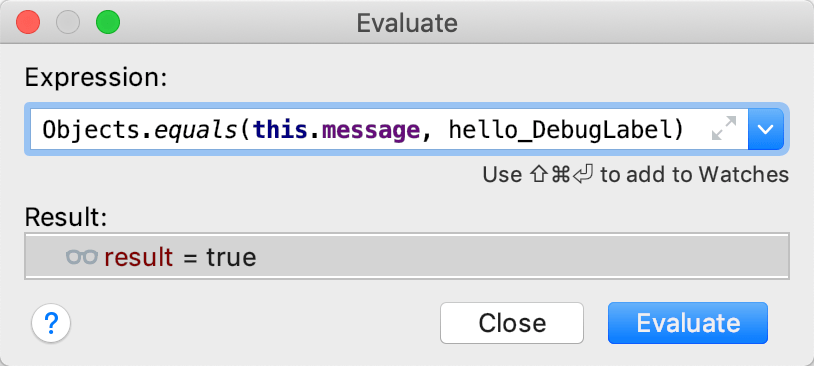
If you want to keep track of an instance regardless of the context, create a watch for this label. With this type of watch, the object is always at hand irrespective of the current frame and thread.
On the Variables tab, right-click a variable or a watch which is currently referring to the object you want to track. From the menu, select Mark Object .
Enter the name for the label. Optionally, you can select the display color. For this, click
and select the color. After you have finished with configuration, click OK.

Right-click the label that you want to remove and select Unmark Object from the menu.
Examining the program state involves navigating in code, and you often need to return to the place where your program is suspended.
Do one of the following:
Go to Run | Debugging Actions | Show Execution Point.
Press .
Click
on the stepping toolbar of the Debug tool window.
The current execution point is indicated with a blue line. The code at this line has not been executed yet.
